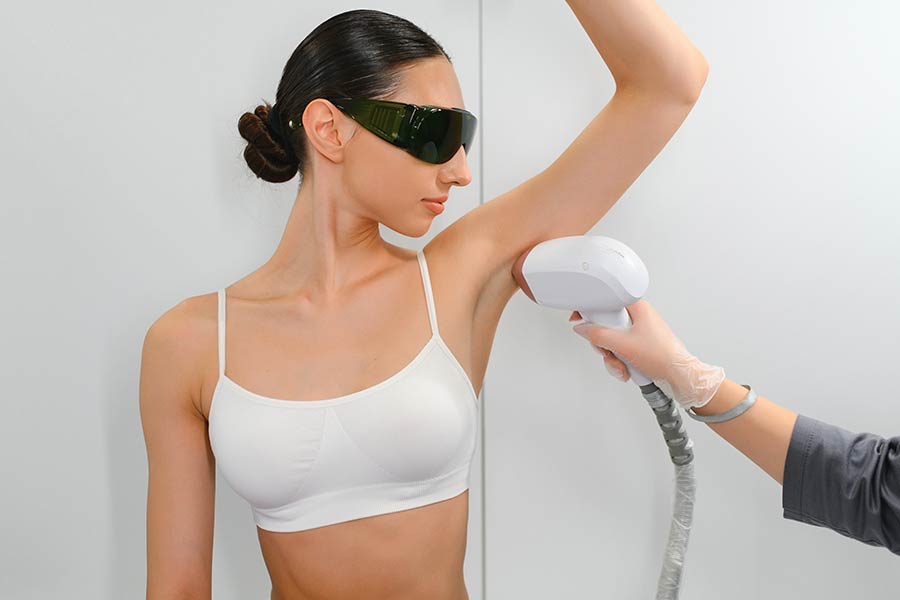What is Laser Hair Removal?
Laser hair removal is a safe and effective treatment that provides a long-term solution for unwanted body and facial hair. This non-invasive procedure uses laser technology to target and destroy hair follicles, preventing future hair growth. During a laser hair removal session, the laser emits a concentrated beam of light absorbed by the pigment in the hair shaft. The energy from the laser is then converted into heat, which damages the hair follicles and inhibits their ability to produce new hair. Laser hair removal works best on darker hair colors and is suitable for various skin tones. However, it may not be as effective on lighter hair colors or gray hair. Multiple treatment sessions are usually required to achieve optimal results, as laser hair removal works best on hair in the active growth cycle. It is important to note that laser hair removal is not completely permanent, but it does provide a significant reduction in hair growth. The procedure has minimal recovery time and can be performed on various areas of the body, making it a popular and effective treatment option for those looking to remove unwanted hair.
Benefits of Laser Hair Removal
If you're tired of constantly dealing with unwanted body hair, laser hair removal may be the perfect solution for you. This highly effective treatment not only reduces and eliminates unwanted hair, but it also provides long-lasting results that leave your skin beautifully bare and smooth.
One of the greatest benefits of laser hair removal is its ability to provide long-lasting results. Unlike traditional hair removal methods like shaving or waxing, laser hair removal targets the hair follicle, offering permanent hair reduction. This means you can say goodbye to the endless cycle of hair growth and regular maintenance.
Not only does laser hair removal save you time and effort, but it also eliminates the need for shaving and waxing. This means no more painful ingrown hairs, razor burns, or unwanted stubble. Laser hair removal works on all skin tones and hair colors, making it a versatile and effective treatment for almost everyone.
In addition to its practical advantages, laser hair removal also offers cosmetic benefits. By removing unwanted body hair, you can achieve silky smooth skin that is perfect for both everyday life and special occasions. No more worrying about the hassle of shaving or waxing before hitting the beach or wearing your favorite outfit.
To experience the benefits of laser hair removal yourself, simply search for a clinic offering this treatment near you. With a few sessions, you'll be on your way to enjoying long-lasting, smooth, and hair-free skin. Say goodbye to unwanted body hair and hello to the freedom and confidence that laser hair removal provides.
Types of Unwanted Hair and Skin Types
Types of Unwanted Hair:
Unwanted hair comes in different forms and can vary in texture, color, and location on the body. It can be coarse, fine, thick, or thin. Some common areas where people commonly seek hair removal treatments include the legs, underarms, bikini line, chin, upper lip, and back. Unwanted hair can also grow on the face, arms, chest, and even buttocks. Whether you're dealing with stubborn facial hair or unwanted body hair, laser hair removal can be an effective solution for getting rid of it permanently.
Skin Types:
When considering laser hair removal, it's essential to understand that different skin types may require different treatment approaches. Laser hair removal works best on individuals with fair to medium skin tones. This is because the laser targets the dark pigment in the hair follicles, and contrasting darker hair against lighter skin makes it easier for the laser to detect and treat the hair follicles. However, advancements in laser technology have made it possible for individuals with darker skin tones to receive effective laser hair removal treatments, although specific considerations and appropriate laser settings are necessary. It's crucial to have a professional consultation to determine the best approach for your specific skin type and hair color to ensure safe and successful laser hair removal sessions.
Unwanted Body Hair
Unwanted body hair can be a nuisance for many individuals, as it can grow in various areas of the body where hair growth is undesirable. From the legs and underarms to the bikini line and chin, dealing with unwanted body hair can be a common concern for both men and women.
One of the main challenges associated with unwanted body hair is the constant need for grooming. Shaving, waxing, and plucking can be time-consuming, and the results are often temporary. Additionally, these hair removal methods can lead to other issues such as ingrown hairs and skin irritation.
That's why finding a long-term solution is crucial for individuals who want to get rid of unwanted body hair. Laser hair removal is an effective treatment that targets the hair follicle, preventing future hair growth. This innovative procedure can result in permanent hair reduction, giving individuals freedom from the constant hassle of grooming and maintaining unwanted body hair.
By opting for laser hair removal, individuals can say goodbye to ingrown hairs, the need for constant grooming, and the discomfort that comes with traditional hair removal methods. It offers a long-term solution for those looking to embrace smooth, hair-free skin. Don't let unwanted body hair hold you back any longer - consider laser hair removal as the perfect solution.
Skin Tones & Skin Colors
When it comes to laser hair removal, the effectiveness of the treatment can be influenced by various factors, including skin tones and skin colors. Laser technology works by targeting the pigment in the hair follicle and hair shaft, which is why different skin tones and colors may require different laser settings or treatments.
Fair skin tones typically have less melanin, the pigment that determines skin and hair color. As a result, fair-skinned individuals are often ideal candidates for laser hair removal, as the contrast between their skin tone and hair color makes it easier for the laser to target the hair follicles without affecting the surrounding skin.
Medium skin tones have slightly more melanin, which means that laser hair removal can still be effective, but certain precautions need to be taken. Using a laser specifically designed for darker hair colors and adjusting the laser settings to accommodate the melanin in the skin can yield successful results for those with medium skin tones.
Olive and dark skin tones have higher levels of melanin, making laser hair removal more challenging. Specialized lasers, such as the Nd: YAG laser, are often used for individuals with darker skin tones to minimize the risk of discoloration or burns.
Ebony skin tones have the highest levels of melanin, making laser hair removal more complex. Choosing the right laser wavelength is crucial for safe and effective treatment in individuals with ebony skin tones.
In conclusion, laser hair removal can be effective for a range of skin tones and colors. However, it's important to consult with a trained professional who can determine the most suitable laser settings and treatments based on individual skin characteristics.
Different Hair Colors & Textures
When it comes to laser hair removal, different hair colors and textures can impact the effectiveness of the treatment. Laser hair removal targets the pigment in the hair follicle and hair shaft, so it is most effective on dark hair colors.
Hair colors such as black and brown contain higher levels of melanin, the pigment that the laser targets, making them ideal for laser hair removal. These darker hair colors allow the laser to effectively destroy the hair follicle and inhibit future hair growth.
On the other hand, hair colors like blonde, red, and gray do not contain enough pigment for the laser to effectively treat. This is because the laser relies on the contrast in pigment between the hair and the skin to selectively target the hair follicle.
In terms of hair textures, laser hair removal works best on coarse, thick hair. The laser can effectively target and destroy the hair follicles in these types of hair, resulting in long-term hair reduction or even permanent hair removal. Fine or thin hair may require more treatment sessions to achieve desired results.
In summary, for the most effective laser hair removal treatment, it is recommended to have dark hair colors and coarse hair textures. However, a consultation with a laser hair removal professional can provide more information about your specific hair color and texture and what results you can expect from the treatment.
Coarse vs. Fine Hair
Coarse and fine hair have distinct characteristics that are relevant to laser hair removal treatments. Coarse hair, typically thicker and darker in color, is more responsive to laser treatments due to its higher pigmentation levels. The laser targets the melanin in the hair follicle, effectively destroying it and inhibiting future hair growth. With its thickness and pigmentation, coarse hair provides optimal conditions for successful laser hair removal.
On the other hand, fine hair has lighter pigmentation and a smaller hair shaft. As a result, it may require additional sessions or alternative methods to achieve desired results. The laser may not effectively target the hair follicle in fine hair due to its lower levels of melanin. While laser hair removal can still be effective for fine hair, it may take more treatments to achieve the desired hair reduction or removal.
When considering laser hair removal, factors such as hair thickness, texture, and pigmentation should be taken into account. Coarse hair, with its thicker texture and darker color, generally responds better to laser treatments. Fine hair, with its lighter pigmentation and smaller hair shaft, may require more sessions or alternative approaches for optimal results. Understanding the distinctions between coarse and fine hair can help determine the most effective treatment plan for laser hair removal.
Understanding the Process of Laser Hair Removal
Laser hair removal is a popular method for achieving long-term hair reduction or removal. This effective treatment targets unwanted body hair by utilizing the power of laser technology. The process involves the use of a concentrated beam of light, which is absorbed by the pigment in the hair follicles. This laser energy then heats and damages the hair follicles, inhibiting future hair growth without causing harm to the surrounding skin. Laser hair removal works best on dark hairs, as the pigment in the hair helps attract and absorb the laser energy. However, advancements in laser technology have made it possible to achieve satisfactory results on a wider range of hair colors and skin tones. To achieve optimal results, multiple laser hair removal sessions are usually required, as hair grows in cycles and the treatment is most effective during the hair growth phase. Overall, laser hair removal offers a long-term solution for unwanted hair, and candidates can discuss their options further through a complimentary consultation with a laser hair removal specialist.
How Does Laser Hair Removal Work?
Laser hair removal is a popular and effective treatment for getting rid of unwanted hair. But how does it work?
Laser hair removal works by targeting the melanin in the hair follicles. Melanin is the pigment responsible for giving hair its color. When the laser emits bursts of high energy light onto the skin, it is absorbed by the melanin in the hair, which then converts that light into heat. This heat damages the hair follicle, destroying its ability to grow back.
To understand why laser hair removal is effective, it is important to know about the different phases of hair growth. Hair goes through three phases: anagen (active growth phase), catagen (transition phase), and telogen (resting phase). The anagen phase is the phase in which hair is actively growing, and it is during this phase that the hair follicle contains the highest concentration of melanin.
Since laser hair removal targets melanin, it is most effective during the anagen phase. However, not all hairs are in the same phase of growth at the same time. This is why multiple treatment sessions are typically needed for complete hair removal.
By harnessing the power of high energy light and targeting the melanin in the hair follicles, laser hair removal offers a long-term solution for unwanted hair. Consult with a professional laser hair removal provider near you to determine if you are a candidate for this effective treatment.
What Happens During a Laser Hair Removal Session?
During a laser hair removal session, the process begins with the client being provided with protective eyewear. The technician will then cleanse the treatment area and apply a cooling gel or numbing cream to ensure comfort during the procedure.
Next, the laser device is used to emit bursts of high-energy light onto the skin. The light is attracted to the melanin in the hair follicles, which absorbs the energy and converts it into heat. This heat damages the hair follicle, preventing future hair growth.
It's important to note that laser hair removal is most effective during the active growth phase of the hair, known as the anagen phase. However, not all hairs are in the same phase at the same time. This is why multiple treatment sessions are usually necessary for optimal results.
The number of treatment sessions required varies depending on individual factors, such as hair color, skin type, and the area being treated. On average, most individuals need about 6 to 8 sessions spaced several weeks apart to achieve significant hair reduction.
One of the main benefits of laser hair removal compared to traditional methods like shaving or waxing is the long-term results it offers. Following a recommended treatment plan and completing the full course of sessions can result in long-term hair reduction, making laser hair removal a more convenient and cost-effective solution in the long run.
In summary, during a laser hair removal session, the targeted melanin in the hair follicles absorbs the energy from the laser, damaging the follicles and preventing future hair growth. Multiple treatment sessions are needed for optimal results, and following a recommended treatment plan can lead to long-term hair reduction.
The Science Behind Laser Technology and Procedures
Laser hair removal is a popular method for achieving long-term hair reduction. The science behind this effective treatment lies in the use of laser technology. The procedure involves the use of specific types of lasers, such as BroadBand Light (BBL) and ClearScan Yag, to target and destroy the hair follicles responsible for hair growth.
During a laser hair removal session, the laser device emits bursts of high-energy light onto the skin. This light is attracted to the melanin, or pigment, in the hair follicles. The melanin absorbs the energy and converts it into heat, which then damages the hair follicle, inhibiting future hair growth.
What makes laser hair removal even more impressive is its ability to selectively target the hair follicles without harming the surrounding skin. This is achieved by adjusting the wavelength and pulse duration of the laser to effectively target the melanin in the hair while minimizing the risk of damage to the skin.
One of the advantages of laser hair removal is that it can be performed on individuals with various skin colors and most hair types. Different types of lasers, like BBL and ClearScan Yag, allow for versatile treatments that effectively address a range of skin tones and hair colors. This makes laser hair removal a suitable option for a wide range of individuals seeking a long-term solution to unwanted hair.
In conclusion, laser hair removal is a science-backed procedure that targets and destroys the hair follicles responsible for hair growth. With the use of specialized lasers like BBL and ClearScan Yag, this treatment provides effective and safe results for individuals with different skin colors and hair types.
Permanent vs. Temporary Hair Reduction/Removal
When it comes to hair reduction or removal, there are two main categories: permanent and temporary methods. Permanent hair reduction techniques, such as laser hair removal, aim to inhibit hair growth over time, while temporary methods provide short-term results and require frequent maintenance.
Laser hair removal is an FDA-approved method for permanent hair reduction. However, it's important to note that it may not completely eliminate hair growth. While the treatment significantly reduces hair regrowth, touch-up sessions may be needed over time to maintain long-lasting results.
On the other hand, temporary hair removal methods include shaving, waxing, and plucking. These techniques provide immediate results but require regular maintenance as hair regrows quickly. Shaving, for example, only removes hair from the surface, leaving the hair shaft intact. Waxing removes hair from the root, but it typically lasts for only a few weeks before regrowth occurs. Plucking removes hair using tweezers, but it can be time-consuming and impractical for large areas.
In contrast, laser hair removal offers long-lasting results by targeting the hair follicles directly. This procedure effectively reduces hair growth, making it a popular choice for those seeking a more permanent solution to unwanted hair.
Effective Ways to Achieve Permanent or Near-Permanent Results
Achieving permanent or near-permanent results with laser hair removal requires a strategic approach. Here are some effective ways to maximize the effectiveness of this treatment:
1. Multiple Treatment Sessions: Laser hair removal targets hair follicles during their active growth phase. Since hair grows in different cycles, it is important to undergo multiple treatment sessions to target all hair growth stages. Consistency is key to ensure that hair follicles are treated at the optimal time for long-lasting results.
2. Reputable Provider: Choosing a reputable and experienced laser hair removal provider is crucial for achieving the best outcomes. An experienced technician will have a deep understanding of different skin types, hair colors, and hair types, allowing them to customize the treatment to your specific needs. Additionally, a reputable provider will use FDA-approved laser technology, ensuring both safety and effectiveness.
3. Pre- and Post-Treatment Care: Following pre- and post-treatment care instructions is essential for minimizing potential side effects and maximizing results. This may involve avoiding sun exposure or tanning beds, as well as keeping the treated area clean and protected. By adhering to these guidelines, you can promote proper healing and enhance the effectiveness of the treatment.
By implementing these strategies and choosing a reputable provider, you can achieve permanent or near-permanent hair reduction with laser hair removal. Remember, consistency, multiple treatment sessions, and proper care are key to obtaining the desired results.
Aftercare for Your Laser Treatment and Maintenance Tips for Optimal Results
Proper aftercare and maintenance are key factors in maximizing the effectiveness of your laser hair removal treatment. By following the right post-treatment care instructions and implementing maintenance tips, you can ensure long-lasting results and enjoy the benefits of permanent or near-permanent hair reduction. After your laser hair removal session, it is important to keep the treated area clean and protected. Avoid sun exposure and tanning beds, as they can increase the risk of complications and interfere with the healing process. Additionally, it is recommended to moisturize the treated area regularly and avoid exfoliating or plucking the hairs. These steps will help to support the healing process and prevent any potential irritation or damage to the skin. To maintain the results, it is advisable to undergo regular touch-up sessions as recommended by your provider. This will target any regrowth and ensure that the treated hair follicles remain in a dormant state. With proper aftercare and maintenance, laser hair removal can provide a long-term solution to unwanted body hair.
Post-Treatment Care to Minimize Discomfort and Speed Up Healing Time
After undergoing a laser hair removal treatment, it is important to follow the necessary post-treatment care to minimize discomfort and speed up healing time. Here are some guidelines to ensure optimal results:
1. Avoid direct sun exposure: The treated area may be sensitive and more prone to sun damage. It is advised to avoid direct sun exposure for at least three to six months following the treatment. When going outside, always wear sunscreen with a high SPF of 30 or higher.
2. Use sunscreen throughout the course of treatment: Even after the initial healing period, it is essential to continue protecting the skin from harmful UV rays. Apply a broad-spectrum sunscreen with SPF 30 or higher to the treated area whenever exposed to the sun.
3. Shave the treatment area: Prior to your laser hair removal session, shave the treatment area the night before. This helps the laser target the hair follicles more effectively.
4. Avoid waxing and depilatory creams: For at least six weeks before the treatment, avoid waxing or using depilatory creams on the area being treated. These methods remove the hair from the root, making it difficult for the laser to target the hair follicle.
By following these steps, you can help minimize discomfort, reduce the risk of complications, and promote faster healing after laser hair removal. Always consult with a licensed professional for personalized post-treatment care advice to ensure the best possible outcomes for your specific situation.












